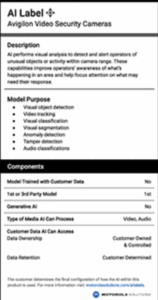A possible future trend that we may start to see everywhere. Like when a movie starts and it has a rating of G, PG-13, or R may be a commonality for AI safety. Last month Motorola Solutions announced it will roll out AI transparency labels for its safety and security products—such as body cameras, video analytics platforms, and command‑center software—used widely by law enforcement agencies. The labels are styled like nutrition facts on food packaging, offering a clear summary of AI details including the type of AI, data ownership, human oversight, and system purpose.

What the AI Nutrition Labels Include
- Type of AI used: machine‑learning, classification, anomaly detection, or generative AI
- Data ownership: first‑party vs. third‑party model provenance
- Human oversight: mechanisms such as human-in-the-loop control
- Purpose: why the AI is included and what it supports (e.g. incident detection, analytics)
Why This Matters
Much of the current discussion around AI transparency is shaped by the EU’s AI Act, which classifies systems by risk level and imposes transparency obligations, especially for high‑risk uses. Motorola’s labels serve as an early, user‑friendly mechanism to satisfy transparency requirements and document key AI features in high‑stakes environments.
Label design builds on earlier efforts like Twilio’s “AI Nutrition Facts” and privacy ladders, which aim to clarify data usage, training set policies, opt‑in mechanisms, and whether models support customization or reuse of user data.
Regulatory Alignment: AI Act and Privacy Frameworks
- EU AI Act: Requires transparency obligations even for limited‑risk systems; high‑risk applications face stricter documentation and oversight requirements. Motorola’s label design aligns with these template expectations and may ease conformity assessments under EU law.
- Privacy frameworks: U.S. state laws (e.g. California’s CPRA, Virginia’s CDPA), and global frameworks emphasize notice and explanation of automated processing. Standardized labels help demonstrate compliance with those transparency provisions.
Nutrition‑Style Labeling: Metaphor and Design
Nutrition facts labels on food provide consumers with standardized, easy‑to‑read data about ingredients and nutritional value. Similarly, AI nutrition labels distill complex AI system details into digestible, consistent components—supporting informed trust and accountability.
Strategic Benefits of Labeling
- Helps users—such as public safety officials—understand at a glance what AI does and who controls data.
- Demonstrates proactive governance: Motorola says it developed the labels with oversight from an internal ethics advisory committee.
- Sets an industry benchmark: first in public safety/enterprise security to adopt nutrition‑style AI labeling.
Takeaways for Regulators & Practitioners
- Manufacturers of high‑risk AI should consider labeling as a compliance and trust‑building tool.
- Labels support explainability, traceability, and transparency—three pillars expected in upcoming AI regulations globally.
- Regulations like the EU AI Act will likely favor or require structured disclosures; nutrition labels provide a scalable approach.
AI Style Labeling Software
Motorola Solutions is pioneering AI nutrition-style labeling in public safety tech—a timely and strategic move as AI transparency becomes regulated and demanded by users. The initiative not only anticipates requirements under the EU AI Act, but it also aligns with emerging global privacy and accountability frameworks. Labeling AI this way may soon become a standard practice for trusted, regulated deployment in safety‑critical contexts.
If it becomes a requirement Captain Compliance can provide the AI Compliance software to make labels and make sure you’re following the legal requirements.